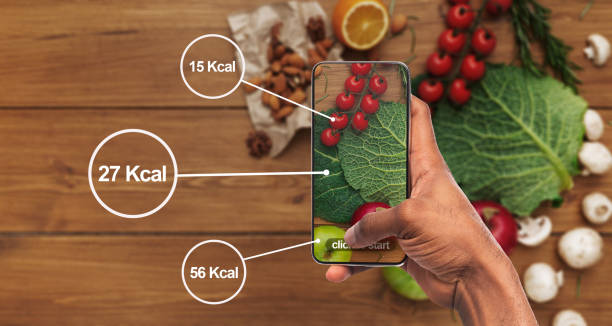So, you’ve decided to lose weight. That’s a fantastic goal! But as you’ve probably noticed, the internet is full of confusing advice, crash diets, and conflicting information. It’s enough to make anyone’s head spin. But what if I told you that the key to weight loss isn’t a secret diet pill or a “miracle” food? The truth is, it all comes down to a simple, scientific principle: calories. Once you understand how to calculate calories for weight loss, you hold the power to take control of your health journey in a sustainable, effective way.
In this comprehensive guide, we’re going to break down the entire process, step-by-step. We’ll go from the basic science to the exact calculations and give you all the practical tips you need to succeed. There’s no fluff or complicated jargon here—just a clear, easy-to-follow plan to help you reach your goals.
The Golden Rule of Weight Loss: Understanding the Calorie Deficit
Contents
- 1 The Golden Rule of Weight Loss: Understanding the Calorie Deficit
- 2 Step 1: Finding Your Baseline – Basal Metabolic Rate (BMR)
- 3 Step 2: Accounting for Your Life – Total Daily Energy Expenditure (TDEE)
- 4 Step 3: Creating Your Calorie Target for Sustainable Weight Loss
- 5 Beyond the Numbers: The Importance of What You Eat
- 6 Putting It All into Practice: Tracking, Tools, and Tips
- 7 Frequently Asked Questions (FAQs) About Calorie Counting
Before we get to the math, we need to understand the single most important rule of weight loss: the calorie deficit. This is the foundation of everything.
What is a Calorie, Really?
A calorie is simply a unit of energy. The food and drinks you consume provide your body with energy (calories) to function. Your body uses this energy for everything from breathing and thinking to walking and exercising. When you talk about the calories in a piece of toast or a can of soda, you’re talking about the amount of energy that food provides.
Why a Deficit is Non-Negotiable
A calorie deficit for weight loss means you’re consuming fewer calories than your body burns each day. Think of your body like a car with a fuel tank. If you put less gas in the tank than you burn on your trip, the car has to use its reserves. For your body, those reserves are your fat stores.
When you consistently eat fewer calories than your body needs, it starts to tap into that stored fat to make up the energy difference. This leads to a gradual, steady, and sustainable loss of body fat.
So, how big of a deficit do you need?
- It’s generally accepted that one pound of body fat contains about 3,500 calories.
- To lose one pound per week, you need to create a deficit of 3,500 calories over seven days.
- That means a daily deficit of 500 calories (3,500÷7=500).
- If you want to lose two pounds per week, you’d aim for a daily deficit of 1,000 calories.
This is the central idea behind all effective weight loss. Now, let’s figure out how many calories your body actually burns in a day.
Step 1: Finding Your Baseline – Basal Metabolic Rate (BMR)
Your Basal Metabolic Rate, or BMR, is the number of calories your body burns just by existing. Even if you were to lay in bed all day and do nothing, your body would still burn this many calories to keep your heart pumping, your lungs breathing, and your organs functioning. Your BMR is your starting point.
To get an accurate number, we’ll use a widely respected formula called the Mifflin-St Jeor Equation.
The Mifflin-St Jeor Equation Explained Simply
This formula uses your sex, weight, height, and age to give you a very good estimate of your BMR.
- For Men: BMR = (10×weight in kg) + (6.25×height in cm) – (5×age in years) + 5
- For Women: BMR = (10×weight in kg) + (6.25×height in cm) – (5×age in years) – 161
Let’s do a quick example together.
Imagine a woman who is 30 years old, 5’5” tall, and weighs 150 lbs.
- Convert her weight: 150 lbs × 0.453592 = 68 kg
- Convert her height: 5’5” = 65 inches × 2.54 = 165 cm
- Plug the numbers into the formula: BMR = (10×68) + (6.25×165) – (5×30) – 161
- Solve the equation: BMR = 680 + 1031.25 – 150 – 161 = 1400.25
So, her BMR is approximately 1,400 calories. This means her body burns about 1,400 calories a day just to keep the lights on.
Why Your BMR Isn’t the Whole Story
Your BMR is a great baseline, but it doesn’t account for the calories you burn when you move around. That’s where the next step comes in.
Step 2: Accounting for Your Life – Total Daily Energy Expenditure (TDEE)
Your Total Daily Energy Expenditure (TDEE) is the total number of calories you burn in a single day, including your BMR, your daily activities, and any exercise you do. This is the most accurate number you’ll need to create your calorie deficit.
To find your TDEE, you simply take your BMR and multiply it by an “activity factor.”
Choosing the Right Activity Factor for You
Be honest with yourself here. It’s easy to overestimate how active you are.
- Sedentary (little to no exercise): BMR × 1.2
- This is for people who sit at a desk all day and do very little physical activity.
- Lightly Active (light exercise 1-3 days per week): BMR × 1.375
- You might go for a brisk walk a few times a week or do a light workout.
- Moderately Active (moderate exercise 3-5 days per week): BMR × 1.55
- This is for people who hit the gym regularly or play sports a few times a week.
- Very Active (hard exercise 6-7 days per week): BMR × 1.725
- You train intensely every day or have a very physically demanding hobby.
- Extra Active (very hard exercise, physical job): BMR × 1.9
- This is for professional athletes or people with jobs that involve heavy physical labor all day.
Let’s finish our example:
Our imaginary woman’s BMR is 1,400 calories. She works an office job but goes to the gym 3-4 times a week, so she would be considered Moderately Active.
- TDEE = 1,400 × 1.55 = 2,170 calories.
Her TDEE is 2,170 calories. This is the number she needs to eat each day to maintain her current weight.
Step 3: Creating Your Calorie Target for Sustainable Weight Loss
Now for the final and most exciting step. You know your TDEE, so you can easily create your calorie deficit to start losing weight.
The “Magic” Numbers: 500 and 1,000 Calories
- To lose 1 pound per week, you subtract 500 calories from your TDEE.
- Our example woman’s target for 1 lb/week: 2,170 – 500 = 1,670 calories per day
- To lose 2 pounds per week, you subtract 1,000 calories from your TDEE.
- Her target for 2 lbs/week: 2,170 – 1,000 = 1,170 calories per day
For most people, aiming for a 500-calorie deficit is the best and most sustainable approach. It allows you to lose weight at a healthy pace without feeling overly restricted or hungry all the time.
Why You Shouldn’t Drop Your Calories Too Low
While a deficit is necessary, a severe one is not a good idea. A crash diet where you eat an extremely low number of calories (below 1,200 for women and 1,500 for men) can backfire.
- Muscle Loss: Your body will start to burn muscle for energy instead of just fat.
- Slowed Metabolism: When you eat too little, your body goes into “survival mode” and slows down your metabolism to conserve energy, making it harder to lose weight in the long run.
- Nutrient Deficiencies: You may not be getting enough vitamins and minerals, which can harm your health.
- Unhealthy Relationship with Food: Extreme restriction can lead to binge eating and a negative relationship with food.
Always aim for a moderate, sustainable deficit. The goal is to lose fat, not just weight, and to do it in a way that you can maintain for life.
Beyond the Numbers: The Importance of What You Eat
Calorie counting is a fantastic tool, but not all calories are created equal. Eating 1,500 calories of junk food will not have the same effect on your body as 1,500 calories of whole, nutritious foods. To maximize your results and feel your best, you need to focus on your macronutrients.
The Power of Protein: Building Muscle and Beating Cravings
Protein is a superstar when it comes to weight loss.
- Satiety: Protein makes you feel full and satisfied, which helps reduce cravings and the urge to snack.
- Muscle Preservation: When you’re in a calorie deficit, your body can sometimes break down muscle for energy. A high-protein diet helps protect your muscle mass, which is important for a healthy metabolism.
- Thermic Effect: Protein requires more energy to digest than carbs or fat, meaning you burn more calories just by eating it!
Examples of good protein sources: Lean chicken, fish, eggs, Greek yogurt, lentils, beans, and tofu.
Carbs Aren’t the Enemy: Choosing the Right Ones
Carbohydrates have gotten a bad reputation, but they are essential for energy. The key is to choose the right kind.
- Good Carbs (Complex Carbs): These are found in whole foods and contain fiber, which slows down digestion and gives you sustained energy. They include oats, brown rice, whole-wheat bread, fruits, and vegetables.
- Bad Carbs (Simple Carbs): These are found in processed foods and give you a quick burst of energy followed by a crash. They include white bread, sugary drinks, and candy.
Focusing on complex carbs will give you the energy you need for your workouts and daily life without causing energy crashes.
Don’t Fear the Fat: Essential Fats for Health
Healthy fats are vital for hormone production, brain health, and nutrient absorption. They also help you feel full.
- Good Fats: These are unsaturated fats found in foods like avocados, olive oil, nuts, and seeds.
- Bad Fats: These are saturated and trans fats found in processed junk food, fried food, and fatty cuts of meat.
A healthy amount of good fats in your diet is crucial for overall health and will not hinder your weight loss.
Putting It All into Practice: Tracking, Tools, and Tips
Now that you have all the numbers, how do you actually apply this to your daily life?
How to Track Your Food Accurately
- Food Tracking Apps: This is the easiest way to track. Apps like MyFitnessPal, Lose It!, and Cronometer have huge databases of foods and can automatically calculate your calories and macros.
- Food Scale: For the most accurate tracking, a food scale is your best friend. A handful of almonds can be a very different number of calories from a measured serving.
- Meal Planning: Plan your meals for the week. This makes it easier to track your calories and avoid last-minute, impulsive food choices that are often high in calories.
The Importance of Consistency and Patience
Weight loss is not a linear journey. Some weeks you might lose more than others, and some weeks you might not see any change on the scale at all. This is normal.
- Trust the Process: If your numbers are correct and you’re being consistent, the scale will eventually move.
- Look Beyond the Scale: Pay attention to other things. Do your clothes fit better? Do you have more energy? Are you getting stronger? These are all signs of progress.
- It’s a Marathon, Not a Sprint: Sustainable weight loss is a long-term goal. Focus on making small, healthy changes that you can stick with for the rest of your life.
Adjusting Your Calories as You Progress
As you lose weight, your body will need fewer calories to function. This means that the TDEE you calculated at the beginning will no longer be accurate.
- Every 10-15 pounds you lose, you should recalculate your BMR and TDEE.
- This will give you a new calorie target that is right for your new, lighter body. It’s an essential part of a long-term plan.
Frequently Asked Questions (FAQs) About Calorie Counting
Q1: Does calorie counting work for everyone?
A: The principle of a calorie deficit works for everyone. However, some people find it tedious to track every single calorie. It’s a great tool for understanding your eating habits, but you don’t have to do it forever.
Q2: What about exercise? Do I add those calories back?
A: This is a common question. Your TDEE already includes the calories you burn from exercise. It’s generally a bad idea to “eat back” the calories your app says you burned during a workout, as fitness trackers often overestimate calorie burn.
Q3: How do I know if my calculation is correct?
A: You’ll know if your calculation is correct based on your progress. If you’re consistently eating at your target and not losing weight, your TDEE might be a little lower than you thought. You should then adjust your calorie target down by another 100-200 calories and see if that gets you moving in the right direction.
Q4: What if I have a bad day or go over my calories?
A: Don’t beat yourself up about it! One bad day will not ruin your progress. The key is to get right back on track with your next meal. Don’t try to “make up” for it by skipping meals or eating drastically less the next day, as that can lead to a cycle of binging and restricting.
Q5: Is it okay to not count calories forever?
A: Yes! Calorie counting is a fantastic learning tool. It teaches you about portion sizes, what’s in your food, and how to create a balanced plate. After a while, you may develop a good enough sense of your food intake that you no longer need to track every meal.
By following this guide, you are not just counting calories; you are empowering yourself with the knowledge to make informed decisions about your health. This is the first step toward a healthier, happier you.





